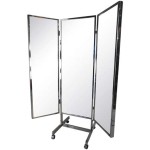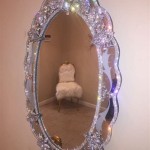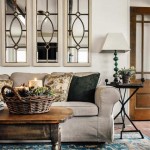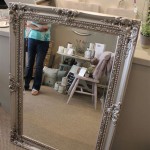How To Attach a Dresser Mirror: A Comprehensive Guide
Attaching a mirror to a dresser can significantly enhance the functionality and aesthetic appeal of a bedroom. A well-placed mirror not only provides a convenient reflection for dressing and grooming but also creates a sense of spaciousness within the room. The process requires careful planning, the right tools, and a methodical approach to ensure a secure and visually appealing result. This article provides a detailed, step-by-step guide on how to attach a dresser mirror safely and effectively.
Preparing for the Attachment Process
Before initiating the attachment process, several preparatory steps are crucial. These steps involve selecting the appropriate mirror and hardware, gathering the necessary tools, and preparing the dresser surface. Neglecting these foundational elements can lead to instability, damage to the dresser or mirror, and an unsatisfactory final outcome.
Firstly, select a mirror that complements the style and dimensions of the dresser. Consider the height, width, and overall design of both pieces of furniture. The mirror should be proportional to the dresser to maintain visual harmony. Mirrors are available in a variety of shapes, including rectangular, oval, and arched. Choose a shape that aligns with the room's decor and personal preferences.
Next, inspect the mirror for any defects, such as scratches, chips, or cracks. Address any minor imperfections before proceeding. A damaged mirror may be unstable and pose a safety hazard during installation. Also, check the backing of the mirror. Ensure it is clean and free from dust or debris, as this can affect the adhesion of mounting hardware.
Selecting the appropriate mounting hardware is paramount. The hardware should be capable of supporting the weight of the mirror securely and preventing it from dislodging. Options include: mirror clips, mounting brackets, and adhesive tapes specifically designed for mirrors. Mirror clips are small metal or plastic fasteners that attach to the dresser frame and hold the mirror in place. Mounting brackets provide a more robust support system, typically used for larger and heavier mirrors. Adhesive tapes, such as double-sided mirror tape, offer a simpler installation method but are best suited for lighter mirrors.
Gather the required tools before starting the installation. Essential tools typically include: a measuring tape, a level, a pencil, a drill with appropriate drill bits, a screwdriver (Phillips head or flathead, depending on the screws used), safety glasses, and construction adhesive (optional, for added security). Safety glasses are crucial to protect the eyes from debris while drilling and handling hardware. A level ensures that the mirror is mounted straight and avoids a skewed appearance.
Finally, prepare the dresser surface. Clean the area where the mirror will be attached with a mild detergent and water. Remove any dust, grease, or old adhesive residue. Allow the surface to dry completely before proceeding. A clean surface ensures optimal adhesion of mounting hardware or adhesive tapes. If the dresser surface is uneven or damaged, consider using shims to create a level mounting surface. Shims are thin pieces of wood or plastic that can be inserted behind the mirror to compensate for irregularities.
Attaching the Mirror Using Different Methods
Depending on the type of mounting hardware chosen, different attachment methods are employed. Each method has its advantages and disadvantages in terms of ease of installation, stability, and aesthetic appeal. Three common methods are detailed below: using mirror clips, mounting brackets, and adhesive tape.
Method 1: Using Mirror Clips
Mirror clips are a popular choice for attaching mirrors due to their simplicity and affordability. They consist of small metal or plastic clips that secure the mirror to the dresser frame. This method is suitable for mirrors of moderate size and weight.
First, measure and mark the desired location of the mirror on the dresser. Use a measuring tape and a pencil to accurately mark the top and bottom corners. Ensure that the mirror is centered and aligned with the dresser. A level can be used to verify that the marks are straight.
Next, determine the placement of the mirror clips. Typically, four clips are used: two at the top and two at the bottom. Position the clips so that they firmly grip the edges of the mirror without obstructing the view. Ensure that the clips are evenly spaced and aligned with the marked corners.
Pre-drill pilot holes at the marked locations for the mirror clips. Use a drill bit that is slightly smaller than the screws provided with the clips. Pilot holes prevent the wood from splitting and make it easier to drive in the screws straight. Exercise caution while drilling to avoid damaging the dresser surface.
Attach the mirror clips to the dresser frame using the screws provided. Tighten the screws securely, but avoid over-tightening, as this can strip the threads or damage the clips. Ensure that the clips are firmly fixed to the dresser and can hold the weight of the mirror.
Carefully slide the mirror into the mirror clips. Ensure that the edges of the mirror are securely gripped by the clips. The mirror should fit snugly and not wobble or move excessively. If necessary, adjust the position of the clips to achieve a secure fit.
Method 2: Using Mounting Brackets
Mounting brackets provide a more robust support system for larger and heavier mirrors. They typically consist of metal brackets that attach to both the dresser and the mirror, providing a strong and stable connection.
Begin by measuring and marking the desired location of the mirror on the dresser, similar to the mirror clip method. Use a measuring tape, pencil, and level to ensure accurate placement and alignment.
Next, attach the mounting brackets to the back of the mirror. Some brackets require pre-drilling holes in the mirror frame, while others attach with adhesive. Follow the manufacturer's instructions for attaching the brackets securely. Ensure that the brackets are evenly spaced and aligned with the marked corners on the dresser.
Position the mirror with the attached brackets against the dresser. Align the brackets with the marked locations. Pre-drill pilot holes on the dresser frame, corresponding to the mounting holes on the brackets. Use a drill bit that is slightly smaller than the screws provided.
Attach the mirror and brackets to the dresser frame using screws. Tighten the screws securely, ensuring that the brackets are firmly fixed to both the mirror and the dresser. Check the stability of the mirror by gently rocking it back and forth. If necessary, adjust the brackets or add additional screws for increased support.
Method 3: Using Adhesive Tape
Adhesive tape, specifically designed for mirrors, offers a simpler installation method. This method is suitable for lighter mirrors and requires minimal tools. It is important to use high-quality mirror tape to ensure a strong and long-lasting bond.
Thoroughly clean the back of the mirror and the dresser surface with a mild detergent and water. Remove any dust, grease, or residue. Allow both surfaces to dry completely.
Apply strips of mirror tape to the back of the mirror. Position the strips vertically, evenly spaced across the surface. Leave a small gap between each strip to allow for ventilation and prevent moisture buildup.
Peel off the protective backing from the mirror tape. Carefully align the mirror with the desired location on the dresser. Press the mirror firmly against the dresser surface, applying even pressure across the entire surface.
Maintain pressure on the mirror for several minutes to allow the adhesive to bond properly. Refer to the manufacturer's instructions for the recommended bonding time. Use painter's tape to temporarily secure the mirror in place while the adhesive cures. This prevents the mirror from sliding or shifting during the curing process.
Ensuring Stability and Safety
Regardless of the attachment method used, ensuring the stability and safety of the attached mirror is crucial. A poorly secured mirror can pose a significant safety hazard, especially in households with children or pets. Several measures can be taken to enhance the stability and safety of the installation.
First, double-check the tightness of all screws and fasteners. Periodically inspect the hardware for any signs of loosening or wear. Tighten any loose screws immediately to prevent the mirror from becoming unstable.
Consider using construction adhesive in conjunction with other mounting methods for added security. Apply a small amount of construction adhesive to the back of the mirror, in addition to using mirror clips or mounting brackets. The adhesive provides an extra layer of bonding and helps to distribute the weight of the mirror evenly.
For larger and heavier mirrors, consider anchoring the dresser to the wall. This prevents the dresser from tipping over, especially if the mirror adds significant weight and height. Use appropriate wall anchors and screws to secure the dresser to a wall stud. This provides a stable base for the mirror and reduces the risk of accidents.
Regularly inspect the mirror for any signs of damage, such as cracks or chips. Replace the mirror immediately if any damage is detected. A damaged mirror can be unstable and pose a safety hazard. In addition, avoid placing heavy objects on the dresser that could potentially dislodge the mirror or compromise its stability.
By following these detailed instructions and taking necessary precautions, one can successfully attach a mirror to a dresser, enhancing both its functionality and aesthetic appeal, while ensuring the safety of the surrounding environment.

Heavy Duty Dresser Mirror Support Brackets Made In The Usa

Fitting Dresser Mirror

How Can I Raise The Height Of Mirror On This Vintage Dresser Hometalk

Dresser Mirror Brackets September 2024 Your Guide

How To Fasten A Mirror Dresser Swiss Valley Furniture

Mirror Supports Moheco S

Dresser Mirror Idea Turn A Into Shelf Easy Diy Project

American Freight How To S Attach A Mirror Dresser

How To Repurpose An Old Swivel Mirror Confessions Of A Serial Do It Yourselfer

How To Repurpose An Old Swivel Mirror Confessions Of A Serial Do It Yourselfer








